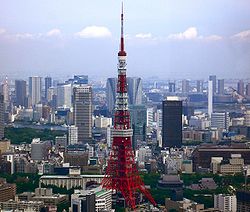| Part of a series on the |
| History of Japan |
|---|
 |
The Japanese asset price bubble (バブル景気, baburu keiki, lit. 'bubble economy') was an economic bubble in Japan from 1986 to 1991 in which real estate and stock market prices were greatly inflated.[1] In early 1992, this price bubble burst and Japan's economy stagnated. The bubble was characterized by rapid acceleration of asset prices and overheated economic activity, as well as an uncontrolled money supply and credit expansion.[2] More specifically, over-confidence and speculation regarding asset and stock prices were closely associated with excessive monetary easing policy at the time.[3] Through the creation of economic policies that cultivated the marketability of assets, eased the access to credit, and encouraged speculation, the Japanese government started a prolonged and exacerbated Japanese asset price bubble.[4]
By August 1990, the Nikkei stock index had plummeted to half its peak by the time of the fifth monetary tightening by the Bank of Japan (BOJ).[2] By late 1991, other asset prices began to fall. Even though asset prices had visibly collapsed by early 1992,[2] the economy's decline continued for more than a decade. This decline resulted in a huge accumulation of non-performing assets loans (NPL), causing difficulties for many financial institutions. The bursting of the Japanese asset price bubble contributed to what many call the Lost Decade.[5] Japan's average nationwide land prices finally began to increase year-over-year in 2018, with a 0.1% rise over 2017 price levels.[6]


- ^ "Japan's Bubble Economy". www.sjsu.edu. Archived from the original on 1999-04-21. Retrieved 2009-04-20.
- ^ a b c Kunio Okina, Masaaki Shirakawa, and Shigenori Shiratsuka (February 2001):The Asset Price Bubble and Monetary Policy: Japan's Experience in the Late 1980s and the Lessons
- ^ Edgardo Demaestri, Pietro Masci (2003): Financial Crises in Japan and Latin America, Inter-American Development Bank
- ^ Quinn, William (2020). Boom and Bust: A global History of Financial Bubbles. Cambridge: Cambridge University Press. pp. 134–151. ISBN 9781108421256.
- ^ "Archived copy" (PDF). Archived (PDF) from the original on 2021-07-22. Retrieved 2012-07-15.
{{cite web}}: CS1 maint: archived copy as title (link) - ^ "The Japan News". Archived from the original on 2018-09-21. Retrieved 2018-09-20.